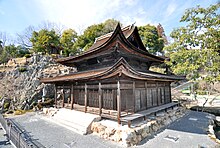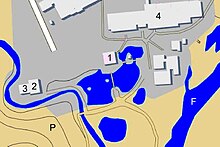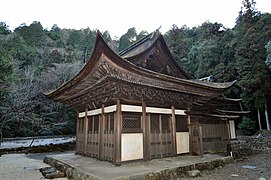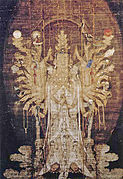Eihō-ji
The Eihō-ji ( Japanese 永保 寺 ) is a temple of the Rinzai direction of Buddhism on the northern edge of the city of Tajimi in Gifu Prefecture .
history
In 1313, at the invitation of the governor of Mino Province , Toki Yorisada ( 土 岐 頼 貞 ; 1271–1339), the priest Musō Soseki came here, accompanied by priest Gen'ōhongen ( 元 翁 本 元 ; 1282–1332) and others and built himself, enchanted by the beautiful landscape, a hermitage in the mountains. This became the origin of Eihō-ji, whereby the area was similar to the famous Tiger Gorge in China on Mount Lu Shan ( Jiangxi Province ) and the hill was called Tiger Gorge Mountain ( 虎 渓 山 , Kokeizan ). Later Genōhongen was commissioned by Emperor Go-Daigo to create a temple. In 1339 this prayer temple became the emperor Kōmyō from the north court and was supported by the Toki in the Muromachi period . At times the temple was surrounded by 30 Klausen, but was then set on fire three times by soldiers during the Sengoku period and lost most of its buildings. Of the sub-temples, only the Hōju-in ( 保 壽 院 ), the Zokuhō-in ( 続 芳 院 ) and the Tokurin-in ( 徳 院 ) have survived.
The attachment
- The Kannon-dō ( 観 音 堂 ; 1 in the map) is also called Kannon-kaku ( 観 音 閣 ) or Suigetsujō ( 水月 場 ) and is registered as a national treasure. According to the Musō annual documents ( 夢 窓 年譜 , Musō nempu ), the small hall was built in 1314 when Musō was 40 years old. The building is exemplary of the eclectic style , namely the combination of the Chinese style transmitted from the Tang period with the building style developed in Japan. In the hall, enclosed in a box, there is a sitting Kannon (an important cultural asset of the prefecture).
- The founder's hall ( 開山 堂 , Kaisan-dō ; 2) is located in the northwest corner of the garden. It dates from the beginning of the Muromachi period, is a classic example of Tang Period architecture and is also registered as a national treasure. In front is the prayer hall, behind it a small hall only for the priests, the Shidō ( 祠堂 : 3). This double structure can be seen as the forerunner of a type of Shinto shrine, it is called there "Gongen construction" ( 権 現 造 , Gongen-zukuri ).
- The main hall ( 本 堂 , Hondō ; 4) and the refectory burned down on a September night in 2003 due to a fire in the neighborhood. Some cult figures were also lost in the fire that destroyed buildings with an area of 910 m². Most of the treasures were housed separately in a treasure house and were preserved.
The garden
The garden is said to have been laid out by Musō as a front garden to the Kannon-do. It is registered as a “national beautiful view of nature” ( 国 名勝 , Kuni-meishō ). Next to the Kannon-dō there is a rock called Bon'ongan ( 梵音 巌 ). The pond in front of the Kannon-do is called Garyu-ike, it is crossed by the Musai Bridge ( 無際 橋 ), something like "Timeless Bridge".
If you cross the small bridge called Sanshō Bridge over the stream in the west, you get to the Tiger Gorge Park ( 虎 渓 公園 ; P). From the top you have a nice view of Tajimi.
Treasures of the temple
One of the treasures of the temple is a thousand-armed Kannon, painted on silk. It is registered as an important cultural asset .
photos
Remarks
- ↑ Garyū ( 臥龍 ) means "the stretching dragon".
- ↑ Sanshō ( 三 笑 ) means "three laughter". This is a reference to the Tiger Canyon in the background. In ancient China, three fearful hikers are said to have crossed the Tiger Gorge there without realizing it and afterwards broke out into liberating laughter.
Individual evidence
- ↑ Mainichi Shimbun-sha (Ed.): Juyo bunkazai 12. Kenzobutsu I. Mainichi Shimbun-sha, 1973.
literature
- Gifu-ken kotogakko kyoiku kenkyukai komin-chireki-bukai, chiri-bukai (Ed.): Eiho-ji. Gifu-ken no rekishi sampo. Yamakawa Shuppan, 2006, ISBN 978-4-634-24621-8 .
Web links
Coordinates: 35 ° 20 ′ 48 ″ N , 137 ° 7 ′ 51 ″ E







